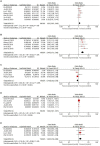Risk factors for perimenopausal depression in Chinese women: a meta-analysis
- PMID: 37886118
- PMCID: PMC10598844
- DOI: 10.3389/fpsyt.2023.1199806
Risk factors for perimenopausal depression in Chinese women: a meta-analysis
Abstract
Objective: To systematically evaluate the risk factors for perimenopausal depression in Chinese women and to provide a basis for screening perimenopausal women at high-risk for depression.
Methods: A computer search of seven databases, including SinoMed, PubMed, Web of Science, and so on, and two clinical trial registries on the risk factors for depression in Chinese women during perimenopause was conducted for meta-analysis. The search time limit was from the establishment of the database to December 2022. The included case-control and cross-sectional studies were evaluated using the Newcastle-Ottawa scale (NOS) and criteria developed by the Agency for Healthcare Research and Quality (AHRQ).
Results: A total of 15 papers with 12,168 patients and 18 risk factors were included. Meta-analysis results showed that the risk factors for depression in perimenopausal women were relationship quality [OR = 1.23, 95% confidence intervals (1.03, 1.46)], marital status [OR = 2.49, 95% CI (1.77, 3.50)], family income [OR = 1.48 95% CI (1.10, 2.00)], comorbid chronic diseases [OR = 2.39, 95% CI (1.93, 2.95)], exercise status [OR = 1.63, 95% CI (1.26, 2.11)], perimenopausal syndrome [OR = 2.36, 95% CI (2.11, 2.63)], age [OR = 1.04, 95% CI (1.01, 1.07)], and stressful events [OR = 12.14, 95% CI (6.48, 22.72)], and social support was a protective factor [OR = 0.76, 95% CI (0.63, 0.91), p < 0.05].
Conclusion: Based on the exploration of risk factors for perimenopausal depression in Chinese women, we aimed to provide guidance for the screening of risk factors for depression in perimenopausal women and thereby reduce the incidence of depression.
Systematic review registration: https://www.crd.york.ac.uk/PROSPERO/#myprospero, CRD42023403972.
Keywords: China; depression; meta-analysis; perimenopausal women; risk factors.
Copyright © 2023 Gan, Yu, Lian, Wei, Li, Yuan and Zheng.
Conflict of interest statement
The authors declare that the research was conducted in the absence of any commercial or financial relationships that could be construed as a potential conflict of interest.
Figures




References
-
- Colvin A, Richardson GA, Cyranowski JM, Youk A, Bromberger JT. The role of family history of depression and the menopausal transition in the development of major depression in midlife women: Study of women's health across the nation mental health study (SWAN MHS). Depress Anxiety. (2017) 34:826–35. doi: 10.1002/da.22651, PMID: - DOI - PMC - PubMed
Publication types
LinkOut - more resources
Full Text Sources

